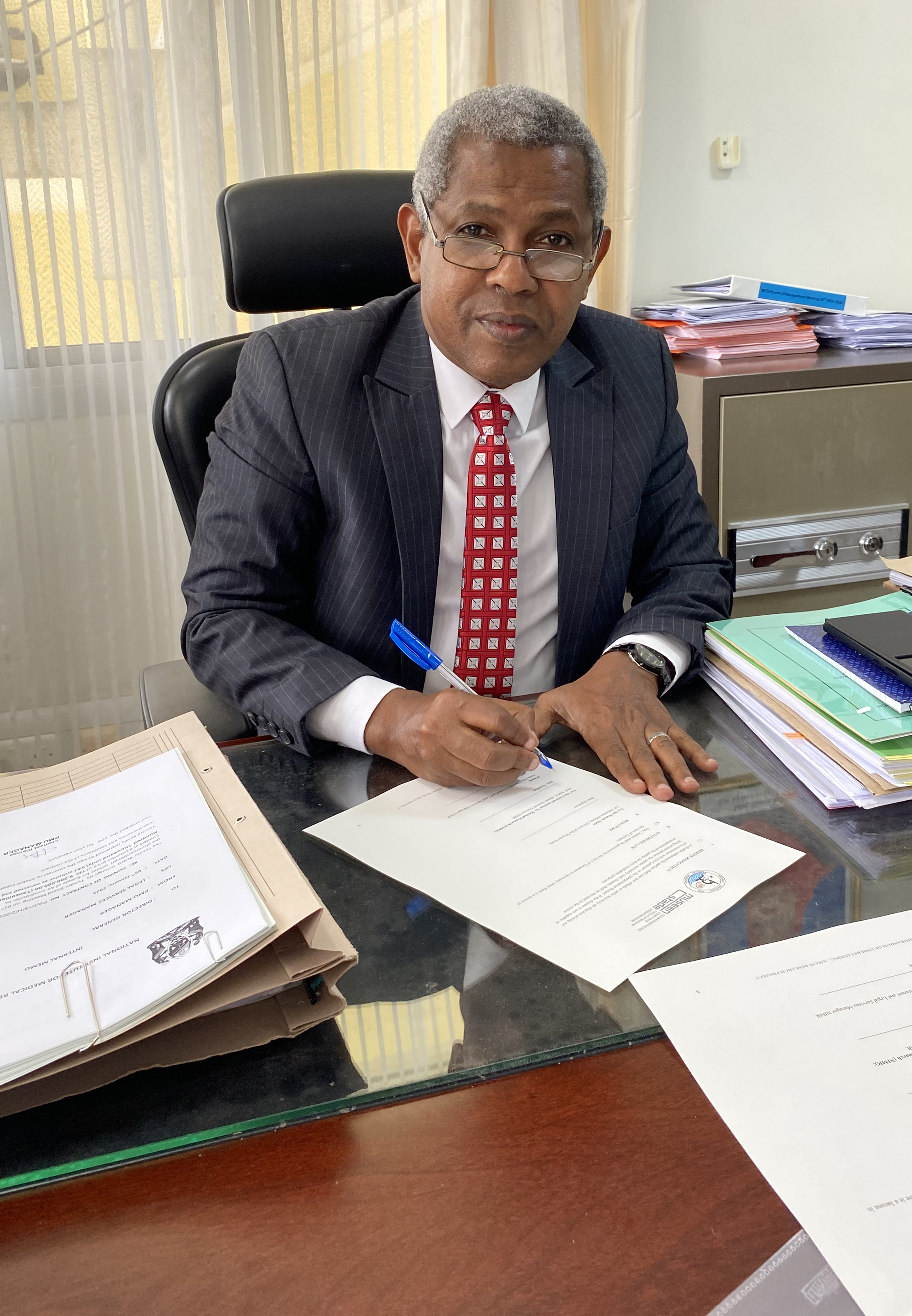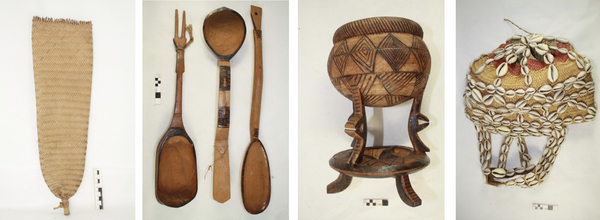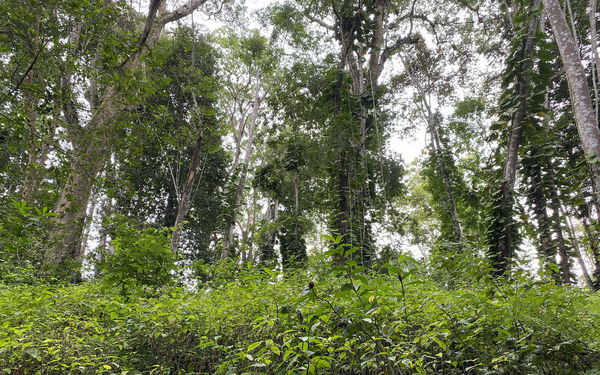MUSEEN STADE RESEARCH A COLONIAL-ERA COLLECTION TOGETHER WITH PARTNER INSTITUTIONS IN TANZANIA |
|
|
|
|
 Panorama postcard of the Amani Institute with personal inscriptions by Karl Braun. © Stadtarchiv Stade, StadtA STD VI 168. Museen Stade have been researching a colonial-era collection from their holdings since May 2022. This undertaking is funded by the German Lost Art Foundation, which has had a special funding focus on collections from colonial contexts since 2019. The collection was given to the city of Stade as a gift in May 1934 by the botanist Karl Braun, who headed the research centre for fruit tree diseases at the Biologische Reichsanstalt für Land- und Forstwirtschaft in Stade until his retirement.
Before Braun came to Stade in 1921, he had worked from 1904 to 1920 at the Amani Institute, a research station set up by the Reichskolonialamt in the Tanzanian Usambara Mountains of what was then "German East Africa". In the course of his work, he meticulously collected ethnographic objects, which he acquired through purchases and donations in the colonial context of injustice. He brought this extensive collection with him to Germany in 1920, when he had to leave the now British colony.
The historic Amani Institute still exists today. It is maintained by the National Institute for Medical Research (NIMR), which created a new research institution at the foot of the Usambaras after the end of the British colonial period, dedicated among other things to malaria research and ethnomedicine.
|
|
|
|
|
 Prof. Said S. Aboud, General Director of NIMR, signs the MoU © Museen Stade |
| Together with this national institution, the Museen Stade are now setting out to further research the collection. To this end, a cooperation agreement was signed in Dar es Salaam on 6 February 2023 by Prof. Said S. Aboud, Director General of the NIMR, and Dr. Sebastian Möllers, Director of Museen Stade, which sets out the common goals and the form of cooperation.
Among other things, the aim is to create a change of perspective with regard to the objects and the history of the institute. Since almost exclusively German sources are available on German colonial history, this period of history has so far been viewed mainly from the perspective of the colonial actors.
|
|
|
|
|
This should now change through the cooperation. It is also important to include the questions of today's Tanzanian academic colleagues.
So far, the function of the scientific institutions of the colonial organs has been researched only very inadequately. Yet their role in the colonial power structure is much greater than one might think at first glance. Often, attention has been focused on the well-known names and their supposedly great life achievements rather than on their crimes. For example, Robert Koch also worked in Amani before setting up his own station at Lake Victoria.
But what is the background of the research activities in the institutions? Among other things, it was about acquiring knowledge of the subjugated, indigenous population, who were interviewed to the point of exhaustion by Karl Braun, for example, as he describes in his diaries and are an important subject of the research project. Another aspect is the effective exploitation of the colonies. Which raw materials can be processed and how, which plants can be cultivated, which animal species can be utilised, etc.? These questions also drove Karl Braun. Many objects in his ethnographic collection were selected by him against this background. |
|
|
|
|
 Selection of objects from the collection of Karl Braun, 1 Bag for filtering coconut oil, 2 Wooden spoon with burn pattern, 3 Wooden vessel with burn pattern, 4 Mask with cowrie shells © Museen Stade The largest botanical garden in the world was to be created in Amani, in colonial competition with a botanical garden of the Netherlands on Java.
Over 3000 plant species from all over the world were brought to Amani and planted. In return, the institute supplied the German botanical gardens and research institutes with seeds and material for their herbaria. The effects of the German gigantomania can still be clearly seen today in the Amani Nature Reserve. The former botanical garden has taken on a life of its own. Countless plant species that do not actually belong in the ecosystem are crowding out the local species. The region is also called the mainland Galapagos, as it is one of the 20 places worldwide with the greatest biodiversity and the most endemic species. This status is threatened, a consequence of German colonial rule, which also brought large-scale plantation management, combined with immense clearing - a change in ecological systems, guided by economic interests, which still has repercussions today.
|
|
|
|
|
 At first glance, a lush tropical vegetation in the Amani Nature Reserve. In fact, most of the plants are invasive species from the German colonial era, which still threaten the partly endemic native flora. © Museen Stade Thus, the consequences of Germany's colonial history are still effective today and lead to manifold problems. Coming to terms with this part of German history is long overdue and is now finally coming into focus. However, it can only be done together with partners from today's Tanzania. The Museen Stade and the German Lost Art Foundation hope that this will be a joint process of coming to terms with the past. "An essential component of research projects in the field of cultural property and collections from colonial contexts is the inclusion of local knowledge and partners from the countries of origin of the collections," says Jan Hüsgen from the German Lost Art Foundation. "We therefore expressly welcome the exemplary cooperation between the Stade museums and the National Institute of Medical Research, which also includes the provision of personnel resources for research in Tanzania."
In order to include other voices beyond the cooperation with the National Institute of Medical Research, a workshop was held in Dar es Salaam on 9 and 10 February 2023, which was also attended by representatives of the National Museum of Tanzania, the University of Dar es Salaam and the Amani Nature Reserve. The event was prepared together with the local Goethe-Institut.
The aim is to develop ideas for subsequent exhibition projects that will present the results of the research project to a broad public in Germany and Tanzania. Artistic contributions from both countries are to broaden the scientific horizon in this context.
Further information on the research project:
https://www.museen-stade.de/schwedenspeicher/service/forschung/sammlung-karl-braun |
|
|
|
|
|
Funders and project partners: |
|
|
|
|
|